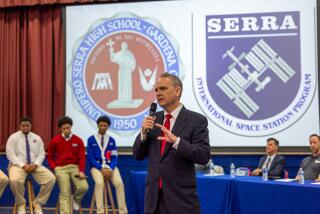Gompers Has Winning Formula at Science Fair
- Share via
Daniel Hauck, 15, wanted to help his friend Andy Burke use a calculator. Andy, who has cerebral palsy, cannot use his arms or legs and is confined to a wheelchair.
So Daniel, a sophomore at Gompers Secondary School, spent 200 hours designing a computer program that allows Andy to use a head stick to operate an on-screen calculator. The project was one of four that won top honors this week at the 35th annual Greater San Diego Science and Engineering Fair in Balboa Park.
“Helping handicapped people, it gives me satisfaction,” said Hauck, who suffered from slowness in speech when he was young. “Many calculator programs already exist, but they require the use of a keyboard. My scanning calculator allows the program to be controlled by an external switch, a head switch attached to a wheelchair.”
Will Compete in International Fair
Two other students from Gompers and one from Bell Junior High in Paradise Hills also received senior sweepstakes awards Wednesday night; all four will compete against more than 700 other students in the International Science and Engineering Fair in Pittsburgh on May 7-13. Each will also receive $2,000 scholarships from the Reuben H. Fleet Space Theater and Science Center.
Thomas Colthurst, 17, a Gompers senior, studied the mathematical properties of fractals and their applications in fields such as computer graphics. Erica Rowe, 17, another Gompers senior, studied the characteristics of a virus that attacks cats.
After a friend whose boat capsized in Lake Capitan contracted giardiasis, 15-year-old Michaela Spehn, a ninth-grader at Bell, decided to study the existence of giardia--parasites that attack mammals’ intestines--in the San Diego River.
Gompers junior Sarah Stockwell, 16, won an alternate sweepstakes award and a free trip to New Zealand for her project on the interactions of hurricanes and tornadoes.
Four junior sweepstakes winners each won $200: Jonah Hershowitz, an eighth-grader at Bell who studied role playing and aggressive behavior; Elyse Salzman, an eighth-grader from San Diego Hebrew Day School who showed how potatoes and lentils can be used to figure out blood types; Janet Lin, an eighth-grader at Muirlands Junior High who looked at the solubility of iron in oolong tea, and Tyson Grant, an eighth-grader at Del Dios Middle School in Escondido who studied the “memory” of metals in terms of how well they retain their shape.
Organizers of the science fair say San Diego students consistently sweep the international competition. Of 68 local students who have won top science fair honors in the past 34 years, “all of them won awards in one or more of the categories (at the international fair). We haven’t struck out once,” said Howard Weisbrod, co-chairman of the San Diego fair.
Last year, San Diego senior sweepstakes winner Laura Magde went on to win the top prize at the international fair in Knoxville, Tenn.: a trip to Stockholm to watch the Nobel Prize presentations.
“We’re one of the oldest fairs. We have teachers out there who insist on high standards. We’re ahead of many fairs on our quality of judging,” said Mary Domb Mikkelson, a member of the fair’s management committee. “They are prominent local scientists, educators and medical personnel.”
Mikkelson, who helped screen thousands of students for the fair, said one longtime judge told her he could not judge the projects this year because he was suddenly called to the White House to serve on a presidential advisory committee.
Number of Prizes Doubled
The fair has gotten so big that the junior and senior prizes were doubled to four each this year.
“The fair started out 35 years ago with 100 exhibitors. Now we have over 700 in the fair who have been selected from roughly 10,000 students from San Diego and Imperial counties,” Weisbrod said.
Students talked to plants and studied while listening to rock music. They wondered whether you can really make a Christmas tree flame-retardant and whether or not parking meters are accurate. They examined camera shutter speeds and skateboard ramp designs.
From earthquake damage reduction to parachute design, from the aerodynamics of model rockets to high-speed, three-dimensional computer graphics, the students showed off projects in a wide variety of subjects, including behavioral sciences, biochemistry, botany, computer science, engineering, environmental sciences, microbiology, physics and zoology.
Titles for other projects included “What Would You Do for a Klondike Bar?” and “Up to Bat: Aluminum or Wood?” and “Which Is the Best Surf Wax?”
More to Read
Sign up for Essential California
The most important California stories and recommendations in your inbox every morning.
You may occasionally receive promotional content from the Los Angeles Times.










